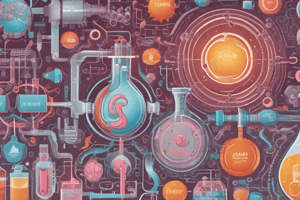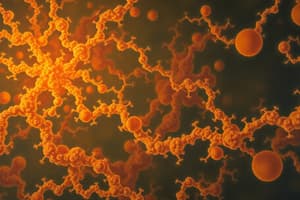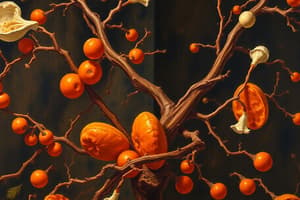Podcast
Questions and Answers
What is the role of insulin in glycogenesis?
What is the role of insulin in glycogenesis?
- It phosphorylates glycogen synthase to increase its activity.
- It stimulates the dephosphorylation of glycogen synthase. (correct)
- It directly catalyzes the formation of UDP-glucose.
- It initiates the synthesis of glucose-6-phosphate.
Which enzyme is responsible for transferring glucose to the growing glycogen molecule?
Which enzyme is responsible for transferring glucose to the growing glycogen molecule?
- UDP-glucose pyrophosphorylase
- Glycogen synthase (correct)
- Branching enzyme
- Glycogenin
What is the significance of branching in glycogen structure?
What is the significance of branching in glycogen structure?
- It prevents the formation of nonreducing ends.
- It decreases the solubility of glycogen.
- It stores glucose exclusively as glucose-6-phosphate.
- It allows for rapid cleavage of glucose residues during glycogenolysis. (correct)
What is required for glycogen synthase to add UDP-glucose to the glycogen chain?
What is required for glycogen synthase to add UDP-glucose to the glycogen chain?
Which of the following correctly describes gluconeogenesis?
Which of the following correctly describes gluconeogenesis?
What type of reactions are primarily involved in the process of glycogenesis?
What type of reactions are primarily involved in the process of glycogenesis?
What is the function of the branching enzyme in glycogenesis?
What is the function of the branching enzyme in glycogenesis?
Which molecule is used to produce uridine diphosphate-glucose?
Which molecule is used to produce uridine diphosphate-glucose?
What is the primary source of glucose-6-phosphate during glycogen synthesis in the liver?
What is the primary source of glucose-6-phosphate during glycogen synthesis in the liver?
What enzyme catalyzes the breakdown of glycogen into glucose-1-phosphate?
What enzyme catalyzes the breakdown of glycogen into glucose-1-phosphate?
Why does glycogen phosphorylase stop cleaving glycogen at an a(1-6) bond?
Why does glycogen phosphorylase stop cleaving glycogen at an a(1-6) bond?
What happens to glucose-1-phosphate during enhanced glycogenolytic activity?
What happens to glucose-1-phosphate during enhanced glycogenolytic activity?
In which tissues is glucose-6-phosphatase expressed, allowing for the conversion of glucose-6-phosphate to free glucose?
In which tissues is glucose-6-phosphatase expressed, allowing for the conversion of glucose-6-phosphate to free glucose?
Which process directly produces glucose from noncarbohydrate sources such as lactate?
Which process directly produces glucose from noncarbohydrate sources such as lactate?
Which of the following correctly describes the regulation of glycogenolysis?
Which of the following correctly describes the regulation of glycogenolysis?
What role does glucagon play in blood glucose regulation concerning glycogen?
What role does glucagon play in blood glucose regulation concerning glycogen?
What is the primary role of glycogen in the body?
What is the primary role of glycogen in the body?
Which enzyme catalyzes the phosphorylation of glucose upon entering muscle cells?
Which enzyme catalyzes the phosphorylation of glucose upon entering muscle cells?
Which pathway describes the breakdown of glycogen into glucose?
Which pathway describes the breakdown of glycogen into glucose?
What is a key function of liver glycogen compared to muscle glycogen?
What is a key function of liver glycogen compared to muscle glycogen?
Which pathway synthesizes glucose from non-carbohydrate sources?
Which pathway synthesizes glucose from non-carbohydrate sources?
What effect does glucose-6-phosphate have on hexokinase activity in muscle cells?
What effect does glucose-6-phosphate have on hexokinase activity in muscle cells?
Which of the following is not a metabolic pathway involved in carbohydrate metabolism?
Which of the following is not a metabolic pathway involved in carbohydrate metabolism?
What is the metabolic fate of glucose when energy needs are low?
What is the metabolic fate of glucose when energy needs are low?
Flashcards
Gluconeogenesis
Gluconeogenesis
The process of producing glucose from non-carbohydrate sources.
Glycogenesis
Glycogenesis
The process of synthesizing glycogen from glucose.
Glycogenolysis
Glycogenolysis
The breakdown of glycogen into glucose for energy.
Glycogen phosphorylase
Glycogen phosphorylase
Signup and view all the flashcards
Glucose-6-phosphatase
Glucose-6-phosphatase
Signup and view all the flashcards
a(1-6) branch point
a(1-6) branch point
Signup and view all the flashcards
Debranching enzyme
Debranching enzyme
Signup and view all the flashcards
Regulation of glycogenolysis
Regulation of glycogenolysis
Signup and view all the flashcards
GLUT4 Translocation
GLUT4 Translocation
Signup and view all the flashcards
GLUT4 Expression
GLUT4 Expression
Signup and view all the flashcards
Liver Glycogen
Liver Glycogen
Signup and view all the flashcards
Muscle Glycogen
Muscle Glycogen
Signup and view all the flashcards
Hexokinase
Hexokinase
Signup and view all the flashcards
UDP-glucose
UDP-glucose
Signup and view all the flashcards
Glycogen synthase
Glycogen synthase
Signup and view all the flashcards
Glycogen primer
Glycogen primer
Signup and view all the flashcards
Active glycogen synthase
Active glycogen synthase
Signup and view all the flashcards
Importance of branching in glycogen
Importance of branching in glycogen
Signup and view all the flashcards
Energy cost of glycogenesis
Energy cost of glycogenesis
Signup and view all the flashcards
Study Notes
Carbohydrate Metabolism
- Carbohydrates are the most abundant organic molecules on Earth.
- They are the primary structural component of plants and provide food energy (starch and sugars).
- Carbohydrates provide half or more of the global human food energy intake.
- They also serve as metabolic intermediates, components of RNA and DNA, structural elements in cells and tissues, and energy storage molecules.
- The diversity of carbohydrates stems from structural diversity.
Carbohydrate Structure
- Carbohydrates are constructed from carbon, hydrogen, and oxygen atoms (approximately in a "hydrate of carbon" ratio - (C−H₂O)ₙ).
- Carbhydrates are categorized into simple and complex carbohydrates.
- Simple carbs include monosaccharides (single sugar unit) and disaccharides (two sugar units).
- Complex carbs include oligosaccharides (3-10 sugar units) and polysaccharides (>10 sugar units, often thousands).
Examples of Simple Carbohydrates
- Monosaccharides include glucose, fructose, and galactose.
- Disaccharides include sucrose (glucose + fructose), lactose (glucose + galactose), and maltose (glucose + glucose).
Examples of Complex Carbohydrates
- Oligosaccharides range from 3-10 sugar units (e.g., raffinose, stachyose).
- Polysaccharides have more than 10 sugar units (e.g., starch, glycogen, dietary fiber).
Complex Carbohydrate Structure
- Amylose is a linear chain of glucose units linked by α(1-4) glycosidic bonds.
- Amylopectin is a branched chain of glucose units with α(1-4) and α(1-6) glycosidic bonds.
- Glycogen is a highly branched polysaccharide of glucose units with both α(1-4) and α(1-6) glycosidic bonds.
Digestion and Absorption of Complex Carbohydrates
- Salivary and pancreatic α-amylases break down amylose/amylopectin to dextrins, maltose and other oligosaccharides.
- Dextrins, maltose, and other oligosaccharides are broken down into monosaccharides by brush border enzymes.
- Monosaccharides are absorbed into the enterocytes of the small intestine through specialized transport proteins (SGLTs and GLUTs).
- SGLTs are sodium-dependent transporters primarily for glucose and galactose (in the apical membrane)
- GLUTs facilitate the diffusion of monosaccharides across enterocyte membranes into the blood.
Summary of Important Carbohydrate Transporters
- GLUT1: Ubiquitous transporter; important for brain development and erythrocyte function.
- GLUT2: High capacity transporter, present in ẞ-cells in the pancreas, liver, intestine, and kidney; plays a role in glucose homeostasis and insulin release.
- GLUT3: High-affinity transporter, found in neurons; important for brain glucose uptake.
- GLUT4: Insulin-sensitive transporter, primarily found in muscle and adipose tissue; crucial for glucose uptake in response to insulin.
- GLUT5: Highly specific for fructose transport.
Blood Glucose Concentration Maintenance
- Maintaining blood glucose is essential for normal cellular function.
- The liver, muscle, and adipose tissue play important roles in blood glucose homeostasis.
- Insulin and glucagon are antagonistic hormones that regulate blood glucose.
- Glycogenesis (glycogen synthesis), glycogenolysis (glycogen breakdown), and gluconeogenesis (glucose synthesis) are essential metabolic pathways.
Glycogenesis
- Glycogenesis is the synthesis of glycogen from glucose.
- This process is catalyzed by enzymes to form a storage form of glucose.
- Glycogen synthase is the primary enzyme and is crucial for the process by stimulated by insulin.
- It is important for energy storage.
- The liver and skeletal muscles are primary sites for glycogen storage, with the liver providing readily available glucose in times of need to regulate blood glucose.
Glycogenolysis
- Glycogenolysis is glycogen breakdown to produce glucose for energy usage or to maintain blood glucose levels.
- Glycogen phosphorylase is the main enzyme, and the process is stimulated by glucagon and epinephrine.
- The liver and muscle cells store glycogen to maintain blood glucose levels or for energy within the cell.
Other Metabolic Pathways
- Glycolysis: Glucose breakdown to pyruvate and ATP
- Pentose phosphate pathway: Important for nucleotide synthesis, antioxidants and energy
- Tricarboxylic acid cycle (TCA cycle): Central pathway, major step in metabolic reactions, produces ATP and intermediates
- Gluconeogenesis: Glucose synthesis from noncarbohydrate precursors (e.g., amino acids and lactate)
Studying That Suits You
Use AI to generate personalized quizzes and flashcards to suit your learning preferences.
Related Documents
Description
Test your knowledge on glycogenesis and gluconeogenesis processes. This quiz covers the roles of enzymes, significance of glycogen structure, and metabolic pathways involved in glucose storage and release. Perfect for students studying biochemistry or related fields.




